Rodrigo C. de Lamare
Shape Adaptive Reconfigurable Holographic Surfaces
Mar 27, 2025Abstract:Reconfigurable Intelligent Surfaces (RIS) have emerged as a key solution to dynamically adjust wireless propagation by tuning the reflection coefficients of large arrays of passive elements. Reconfigurable Holographic Surfaces (RHS) build on the same foundation as RIS but extend it by employing holographic principles for finer-grained wave manipulation | that is, applying higher spatial control over the reflected signals for more precise beam steering. In this paper, we investigate shape-adaptive RHS deployments in a multi-user network. Rather than treating each RHS as a uniform reflecting surface, we propose a selective element activation strategy that dynamically adapts the spatial arrangement of deployed RHS regions to a subset of predefined shapes. In particular, we formulate a system throughput maximization problem that optimizes the shape of the selected RHS elements, active beamforming at the access point (AP), and passive beamforming at the RHS to enhance coverage and mitigate signal blockage. The resulting problem is non-convex and becomes even more challenging to solve as the number of RHS and users increases; to tackle this, we introduce an alternating optimization (AO) approach that efficiently finds near-optimal solutions irrespective of the number or spatial configuration of RHS. Numerical results demonstrate that shape adaptation enables more efficient resource distribution, enhancing the effectiveness of multi-RHS deployments as the network scales.
User Activity Detection with Delay-Calibration for Asynchronous Massive Random Access
Nov 04, 2024
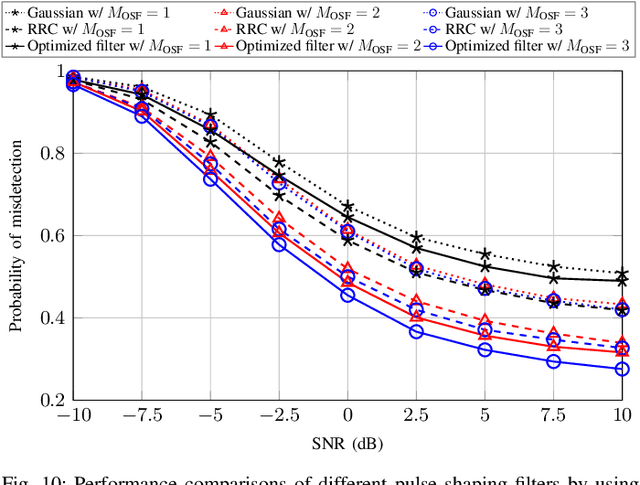
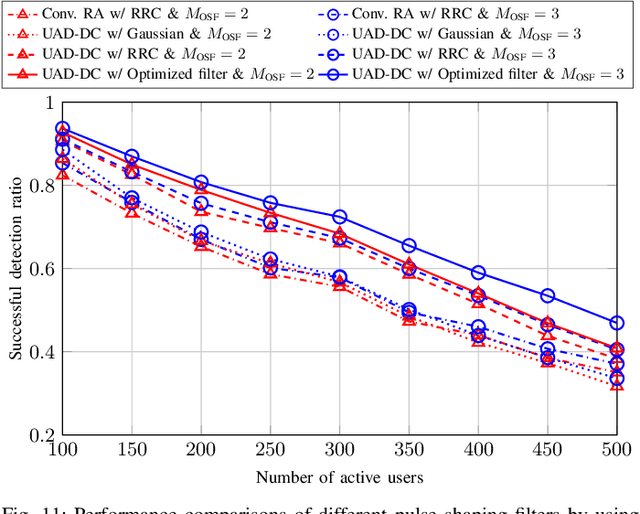
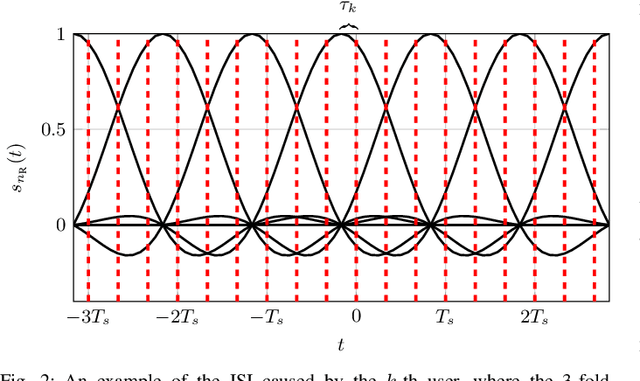
Abstract:This work considers an uplink asynchronous massive random access scenario in which a large number of users asynchronously access a base station equipped with multiple receive antennas. The objective is to alleviate the problem of massive collision due to the limited number of orthogonal preambles of an access scheme in which user activity detection is performed. We propose a user activity detection with delay-calibration (UAD-DC) algorithm and investigate the benefits of oversampling for the estimation of continuous time delays at the receiver. The proposed algorithm iteratively estimates time delays and detects active users by noting that the collided users can be identified through accurate estimation of time delays. Due to the sporadic user activity patterns, the user activity detection problem can be formulated as a compressive sensing (CS) problem, which can be solved by a modified Turbo-CS algorithm under the consideration of correlated noise samples resulting from oversampling. A sliding-window technique is applied in the proposed algorithm to reduce the overall computational complexity. Moreover, we propose a new design of the pulse shaping filter by minimizing the Bayesian Cram\'er-Rao bound of the detection problem under the constraint of limited spectral bandwidth. Numerical results demonstrate the efficacy of the proposed algorithm in terms of the normalized mean squared error of the estimated channel, the probability of misdetection and the successful detection ratio.
Physical Layer Authentication Using Information Reconciliation
Apr 19, 2024Abstract:User authentication in future wireless communication networks is expected to become more complicated due to their large scale and heterogeneity. Furthermore, the computational complexity of classical cryptographic approaches based on public key distribution can be a limiting factor for using in simple, low-end Internet of things (IoT) devices. This paper proposes physical layer authentication (PLA) expected to complement existing traditional approaches, e.g., in multi-factor authentication protocols. The precision and consistency of PLA is impacted because of random variations of wireless channel realizations between different time slots, which can impair authentication performance. In order to address this, a method based on error-correcting codes in the form of reconciliation is considered in this work. In particular, we adopt distributed source coding (Slepian-Wolf) reconciliation using polar codes to reconcile channel measurements spread in time. Hypothesis testing is then applied to the reconciled vectors to accept or reject the device as authenticated. Simulation results show that the proposed PLA using reconciliation outperforms prior schemes even in low signal-to-noise ratio scenarios.
Spatially Non-Stationary XL-MIMO Channel Estimation: A Three-Layer Generalized Approximate Message Passing Method
Mar 05, 2024



Abstract:In this paper, channel estimation problem for extremely large-scale multi-input multi-output (XL-MIMO) systems is investigated with the considerations of the spherical wavefront effect and the spatially non-stationary (SnS) property. Due to the diversities of SnS characteristics among different propagation paths, the concurrent channel estimation of multiple paths becomes intractable. To address this challenge, we propose a two-phase channel estimation scheme. In the first phase, the angles of departure (AoDs) on the user side are estimated, and a carefully designed pilot transmission scheme enables the decomposition of the received signal from different paths. In the second phase, the subchannel estimation corresponding to different paths is formulated as a three-layer Bayesian inference problem. Specifically, the first layer captures block sparsity in the angular domain, the second layer promotes SnS property in the antenna domain, and the third layer decouples the subchannels from the observed signals. To efficiently facilitate Bayesian inference, we propose a novel three-layer generalized approximate message passing (TL-GAMP) algorithm based on structured variational massage passing and belief propagation rules. Simulation results validate the convergence and effectiveness of the proposed algorithm, showcasing its robustness to different channel scenarios.
Joint Visibility Region and Channel Estimation for Extremely Large-scale MIMO Systems
Nov 16, 2023Abstract:In this work, we investigate the channel estimation (CE) problem for extremely large-scale multiple-input-multiple-output (XL-MIMO) systems, considering both the spherical wavefront effect and spatial non-stationarity (SnS). Unlike existing non-stationary CE methods that rely on the statistical characteristics of channels in the spatial or temporal domain, our approach seeks to leverage sparsity in both the spatial and wavenumber domains simultaneously to achieve an accurate estimation.To this end, we introduce a two-stage visibility region (VR) detection and CE framework. Specifically, in the first stage, the belief regarding the visibility of antennas is obtained through a structured message passing (MP) scheme, which fully exploits the block sparse structure of the antenna-domain channel. In the second stage, using the obtained VR information and wavenumber-domain sparsity, we accurately estimate the SnS channel employing the belief-based orthogonal matching pursuit (BB-OMP) method. Simulations demonstrate that the proposed algorithms lead to a significant enhancement in VR detection and CE accuracy, especially in low signal-to-noise ratio (SNR) scenarios.
State Machine-based Waveforms for Channels With 1-Bit Quantization and Oversampling With Time-Instance Zero-Crossing Modulation
Feb 04, 2023



Abstract:Systems with 1-bit quantization and oversampling are promising for the Internet of Things (IoT) devices in order to reduce the power consumption of the analog-to-digital-converters. The novel time-instance zero-crossing (TI ZX) modulation is a promising approach for this kind of channels but existing studies rely on optimization problems with high computational complexity and delay. In this work, we propose a practical waveform design based on the established TI ZX modulation for a multiuser multi-input multi-output (MIMO) downlink scenario with 1-bit quantization and temporal oversampling at the receivers. In this sense, the proposed temporal transmit signals are constructed by concatenating segments of coefficients which convey the information into the time-instances of zero-crossings according to the TI ZX mapping rules. The proposed waveform design is compared with other methods from the literature. The methods are compared in terms of bit error rate and normalized power spectral density. Numerical results show that the proposed technique is suitable for multiuser MIMO system with 1-bit quantization while tolerating some small amount of out-of-band radiation.
Multiuser-MIMO Systems Using Comparator Network-Aided Receivers With 1-Bit Quantization
Nov 18, 2022Abstract:Low-resolution analog-to-digital converters (ADCs) are promising for reducing energy consumption and costs of multiuser multiple-input multiple-output (MIMO) systems with many antennas. We propose low-resolution multiuser MIMO receivers where the signals are simultaneously processed by 1-bit ADCs and a comparator network, which can be interpreted as additional virtual channels with binary outputs. We distinguish the proposed comparator networks in fully and partially connected. For such receivers, we develop the low-resolution aware linear minimum mean-squared error (LRA-LMMSE) channel estimator and detector according to the Bussgang theorem. We also develop a robust detector which takes into account the channel state information (CSI) mismatch statistics. By exploiting knowledge of the channel coefficients we devise a mean-square error (MSE) greedy search and a sequential signal-to-interference-plus-noise ratio (SINR) search for optimization of partially connected networks. Numerical results show that a system with extra virtual channels can outperform a system with additional receive antennas, in terms of bit error rate (BER). Furthermore, by employing the proposed channel estimation with its error statistics, we construct a lower bound on the ergodic sum rate for a linear receiver. Simulation results confirm that the proposed approach outperforms the conventional 1-bit MIMO system in terms of BER, MSE and sum rate.
Randomized Rank-Revealing QLP for Low-Rank Matrix Decomposition
Sep 26, 2022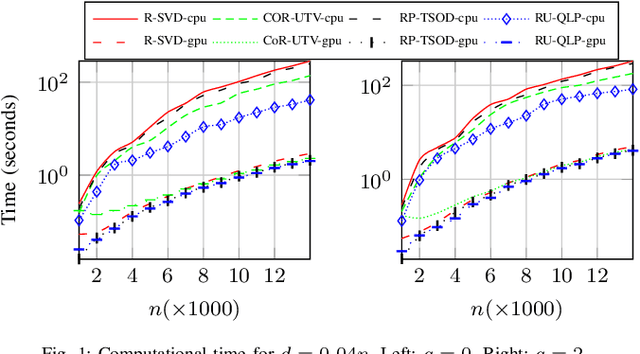
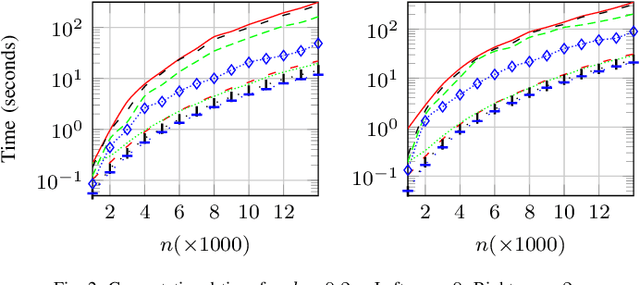
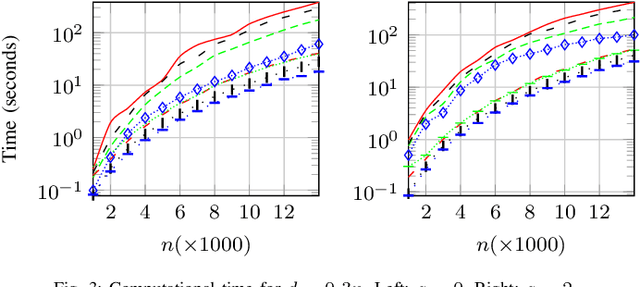
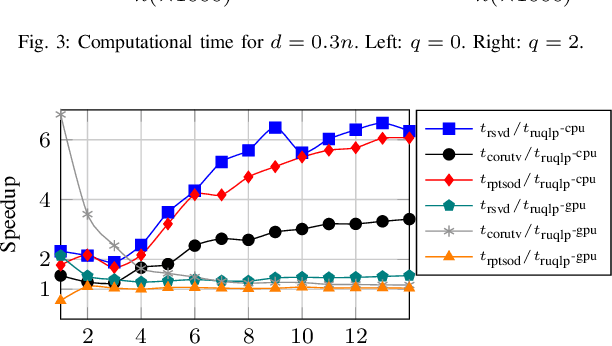
Abstract:The pivoted QLP decomposition is computed through two consecutive pivoted QR decompositions, and provides an approximation to the singular value decomposition. This work is concerned with a partial QLP decomposition of low-rank matrices computed through randomization, termed Randomized Unpivoted QLP (RU-QLP). Like pivoted QLP, RU-QLP is rank-revealing and yet it utilizes random column sampling and the unpivoted QR decomposition. The latter modifications allow RU-QLP to be highly parallelizable on modern computational platforms. We provide an analysis for RU-QLP, deriving bounds in spectral and Frobenius norms on: i) the rank-revealing property; ii) principal angles between approximate subspaces and exact singular subspaces and vectors; and iii) low-rank approximation errors. Effectiveness of the bounds is illustrated through numerical tests. We further use a modern, multicore machine equipped with a GPU to demonstrate the efficiency of RU-QLP. Our results show that compared to the randomized SVD, RU-QLP achieves a speedup of up to 7.1 times on the CPU and up to 2.3 times with the GPU.
Design and Analysis of Robust Resilient Diffusion over Multi-Task Networks Against Byzantine Attacks
Jun 25, 2022



Abstract:This paper studies distributed diffusion adaptation over clustered multi-task networks in the presence of impulsive interferences and Byzantine attacks. We develop a robust resilient diffusion least mean Geman-McClure-estimation (RDLMG) algorithm based on the cost function used by the Geman-McClure estimator, which can reduce the sensitivity to large outliers and make the algorithm robust under impulsive interferences. Moreover, the mean sub-sequence reduced method, in which each node discards the extreme value information of cost contributions received from its neighbors, can make the network resilient against Byzantine attacks. In this regard, the proposed RDLMG algorithm ensures that all normal nodes converge to their ideal states with cooperation among nodes. A statistical analysis of the RDLMG algorithm is also carried out in terms of mean and mean-square performances. Numerical results evaluate the proposed RDLMG algorithm in applications to multi-target localization and multi-task spectrum sensing.
Sparsity-Aware Robust Normalized Subband Adaptive Filtering algorithms based on Alternating Optimization
May 15, 2022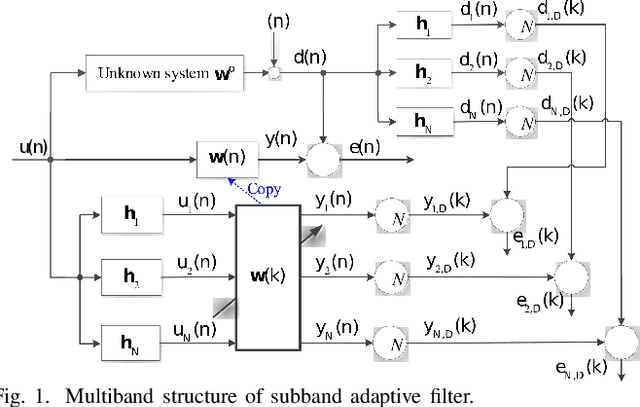

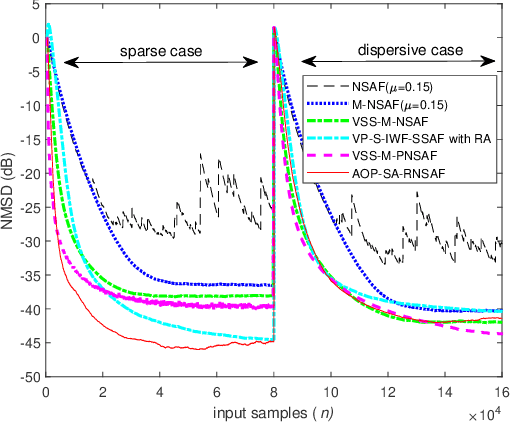
Abstract:This paper proposes a unified sparsity-aware robust normalized subband adaptive filtering (SA-RNSAF) algorithm for identification of sparse systems under impulsive noise. The proposed SA-RNSAF algorithm generalizes different algorithms by defining the robust criterion and sparsity-aware penalty. Furthermore, by alternating optimization of the parameters (AOP) of the algorithm, including the step-size and the sparsity penalty weight, we develop the AOP-SA-RNSAF algorithm, which not only exhibits fast convergence but also obtains low steady-state misadjustment for sparse systems. Simulations in various noise scenarios have verified that the proposed AOP-SA-RNSAF algorithm outperforms existing techniques.
 Add to Chrome
Add to Chrome Add to Firefox
Add to Firefox Add to Edge
Add to Edge